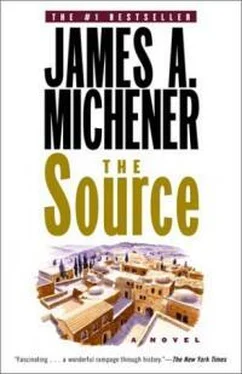“Sir,” Hoopoe protested, “he’s our best workman.”
“I know who he is,” Amram snapped. “He killed my brother.”
“He was sent to us some years ago.”
“I know when he was sent. I sent him.”
Meshab remained silent as General Amram recalled King David’s struggle against the Moabites. In strict fact, the Hebrews had never really defeated the desert kingdom, for Meshab and a few like him had conducted a brilliant strike-and-run defense, but in the end Moab had been reduced to a kind of vassaldom: “As peace was being discussed, this one struck at our camp and slew my brother. When he was captured I wanted to kill him with my own hands.”
He turned away and silence in the room became embarrassing, but Kerith said, “Place the tablets here, slave, and return to camp.” Her command reminded everyone that Meshab was now only a slave and the tension eased. General Amram thought: That woman’s clever.
At the feasts prepared by the governor, the general had additional opportunity to observe the superiority of this woman, and she, guessing at some of the ideas going through his mind, took pains to present herself appealingly: when he wished dates or honey he received them from her, and by the end of the second day it was apparent to General Amram that Hoopoe’s wife wished to be alone with him.
Hoopoe, preoccupied with the chance of gaining authorization for his water system, overlooked his wife but continued to press upon Amram arguments in favor of the tunnel, so on the third day Amram said, “Hoopoe, why don’t you take your Moabite slave and go up the mountain and see if you can lay out the line of flags you’ve been talking about?”
“We’ve already tried,” Hoopoe said. “We’re sure the plan will work.”
General Amram was irritated. “I’ll tell you what to do. You go up on the hill while he stays here, and you can actually erect the flags.”
A flush of joy came over the bearded face of the fat builder. “Does this mean that you are going to authorize the tunnel?”
“Well …” General Amram had about decided not to waste the effort on Makor, but he could now see, standing behind the builder, his lovely waiting wife and something must be done to get rid of the foolish fellow. “Go ahead,” he said on the spur of the moment. “Dig the tunnel.”
“I’ll bring the governor!” Hoopoe cried, and before either Kerith or General Amram could halt him he appeared with the governor, and the authorization for the tunnel was made official. “Now I’ll go on the mountain and locate the flags,” he cried, and with the joy of a child he ran through the streets, calling for the guards to send him Meshab from the slave camp.
When he was safely gone, when the pompous governor had returned in bewilderment to his quarters, wondering how Hoopoe had persuaded General Amram to authorize the water system, the general suggested to Kerith, “Perhaps the slave girls would like to take the children for a walk,” and when the servants were gone he relaxed easily in Hoopoe’s wooden chair and speculated upon what was to happen next.
General Amram was a man with much experience and three wives, two of whom he had taken from other men, and he fancied this lovely Makor woman. Certainly she had given him cause to arrange this meeting and he could guess the reason why: She’s annoyed with her fat little husband who can do nothing but dig holes in the ground. She thinks of anyone from Jerusalem as a man bringing adventure. He had other clever explanations in which he figured large, but none came close to the problem that Kerith now placed before him.
“I wanted to talk to you so much,” she said, sitting primly on a three-legged stool some distance away.
“About what?” he asked with grand condescension.
“I must get to Jerusalem,” she said in a burst of words. “My husband can build so much there. You’ve seen his work. And I …”
“What about you?” the general asked, leaning forward and showing his wide-spaced teeth.
“I want to be where the worship of Yahweh is pure,” she said softly.
“You what?”
“My father was priest here in Makor, and his father before him as far back as we can remember.”
“What’s that got to do with going to Jerusalem?”
And she told him. For the first time in his life General Amram heard the complaint that was going to echo throughout Israel for many centuries: “In Makor we are far from the sources of Yahweh, but in Jerusalem we could live near the sanctuaries of his holiness. In Makor we share the world with Baal; but in Jerusalem, Yahweh alone reigns. In our little town the great kings are not; but in Jerusalem, David lives, and to be near him is to be near the sun.”
“There are many ways you could get to Jerusalem,” the general said, starting to come toward her, but in innocence she misunderstood his purpose and rose to greet him as if he were a travel-weary member of her family.
“You must be very tired,” she said, leading him to a room where tubs of cool water stood. “May I pour the buckets over your head, and then you can sleep.” She made him take off his upper tunic and bend over a drain, while she washed his head as she would have done her father’s. Then she roughened his hair and chest with a heavy cloth and gave him a robe to throw about his shoulders. She led him to a bed and promised to call him if he slept too long, and as she closed the curtains she happened to see her husband on the mountainside. “He’s still up there,” she said, “waving his arms and making silly signals.”
“I intended him to be there … for some time.”
Kerith looked down at the relaxed general, so close to sleep and in such unexpected circumstances, and asked, “How shall we get to Jerusalem, General Amram?”
The warrior looked up at the enticing woman and smiled. “Help him to build his tunnel. When it’s finished the king will surely hear of it.” And before he fell asleep he pictured Hoopoe on the hill, waving his arms.
Hoopoe’s plan was simple. On a spot above the town, but in line with the waterwall, he had planted the first red flag which for the next three years would serve as the standard marker for the job, since it was visible from all parts of the town. Next he had climbed higher and planted a second flag, establishing a range which passed through the first flag, the well and the middle of the waterwall. Whenever the slaves had these two flags in line they could be sure they were properly oriented for digging the tunnel. This completed, he had begun doing what his wife had described to General Amram as “making silly signals.”
On four different roofs in Makor, Hoopoe had stationed slaves with poles to which red flags had been tied, and by means of prearranged signals he was now moving his slaves back and forth until all were in line with the range he had already staked out on the mountainside. When each man was in position he waved a white cloth, and the slaves began fixing their flags in the permanent line that would be used for digging the main shaft.
Meshab the Moabite had been assigned the roof of the governor’s house, for this rose higher than the others and thus formed a prominent landmark; but as the slave walked back and forth among drying seeds to position the important sixth flag which would anchor the range, he annoyed the governor, who left his quarters to cry, “Who is on my roof?”
A crowd collected as the official began ranting at the slave and there might have been trouble, for the Moabite was loath to take down his needed flag, but just as the governor was becoming ugly, General Amram appeared, washed and relaxed, and he could see the desirability of keeping the flag in its present position. He joined Meshab on the roof to study the range of flags, then summoned everyone including Hoopoe to a council below. “The governor is right,” he announced. “The last flag should not be on his roof.” Hoopoe started to protest, but before he could do so the general added, “But since the flag is essential, why not place it on the wall?”
Читать дальше








![Джеймс Купер - Пионеры, или У истоков Саскуиханны [The Pioneers, or The sources of the Susquehannah]](/books/395797/dzhejms-kuper-pionery-ili-u-istokov-saskuihanny-t-thumb.webp)

